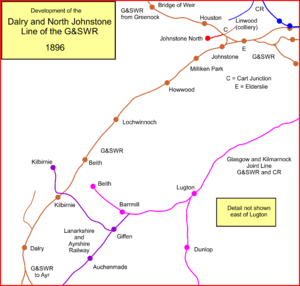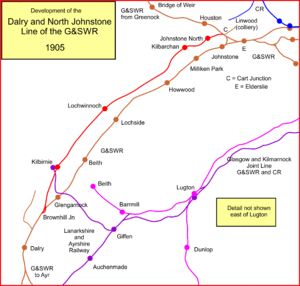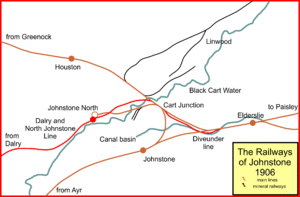Dalry and North Johnstone Line facts for kids
The Dalry and North Johnstone Line was a railway line in Scotland. It was also known as the Lochwinnoch Loop Line or Kilbarchan Loop Line. This line was part of the Glasgow and South Western Railway (G&SWR) network. It connected the towns of Elderslie and Dalry in Renfrewshire and Ayrshire.
The line ran next to an older railway track. It was built to help carry more trains, especially for places like Ayrshire and Kilmarnock. People used the loop line for passenger trains until the mid-1960s. It was closed down as part of big railway changes known as the Beeching Axe. Today, much of the old railway path is used as part of the Sustrans National Cycle Network.
Contents
History of the Line
The Main Railway to Ayr
The Glasgow, Paisley, Kilmarnock and Ayr Railway (GPK&AR) opened its main line between Glasgow and Ayr in 1839-1840. This railway went through towns like Johnstone, Dalry, and Irvine. The part between Glasgow and Paisley was shared with another railway company. Later, the Ayr line became part of the Glasgow and South Western Railway (G&SWR). This company also ran trains to Carlisle, which used the Ayr line as far as Dalry before turning off towards Kilmarnock.
The Paisley Canal Line
Over the years, the main railway line became very busy. Many trains carried minerals, which took up a lot of space on the tracks. This made it hard for passenger trains and other goods trains to run on time. The G&SWR decided to build a new line to avoid the busiest parts. This new line was called the Paisley Canal Line, and it opened in 1885.
The Canal Line started near Glasgow and rejoined the main Ayr line at Elderslie. This gave the G&SWR its own path from its main station in Glasgow. However, this new line followed an old canal path, which meant it had many curves. Trains could not go very fast on it.
Johnstone North Station
The main railway line always had a station in Johnstone. But new factories and industries grew up north and east of the town. These industries used water power from the Black Cart Water river. There were also iron and coal mines nearby.
The G&SWR built a branch line to serve these new industrial areas. In 1895, the G&SWR built another branch line to a new station called Johnstone North. This station was a dead end, meaning trains had to stop there and then go back the way they came. Some trains from the Paisley Canal line used this new station. The Johnstone North line opened on 1 August 1896.
Extending to Dalry
The main railway line continued to get more and more crowded. Even though another line had opened in 1871, helping to send some trains away from Dalry, there was still a lot of heavy mineral traffic. This caused big problems with trains getting delayed. So, the G&SWR decided to build a brand new line from Johnstone North all the way to Dalry. At Dalry, the railway split for Ayr and Kilmarnock.
The old Johnstone North branch line was not built for fast trains. So, the new line was built next to it, but with straighter tracks. It opened on 1 June 1905. The original branch line stayed open for goods trains but no longer carried passengers.
From Johnstone North, the new line ran mostly parallel to the old Ayr line. It went north of Castle Semple Loch and Kilbirnie Loch. New stations were built at Kilbarchan, Lochwinnoch, and Kilbirnie. The line then rejoined the main Ayr line at Brownhill Junction, north of Dalry. This junction was special because it was a flying junction, the first of its kind in Scotland. This meant one track went over or under another, so trains didn't have to cross each other's paths.
Elderslie Dive-Under
At Elderslie, trains going west could either stay on the old main line or turn right towards Greenock. With the new line opening, even more trains needed to turn right to go to Johnstone North and beyond. Also, fast "boat trains" going to Greenock were becoming very important. All these trains turning right caused delays for trains going north on the main line.
To fix this, the G&SWR started building a "burrowing junction" at Elderslie in 1906. This is like a tunnel or underpass for trains. It allowed trains heading for Greenock or Johnstone North to go under the main line. This way, they didn't get in the way of other trains, making everything run smoother.
Passenger Train Service
The Dalry and North Johnstone Line usually had about twelve passenger trains each day. These trains ran from Glasgow St Enoch to places like Ardrossan, Ayr, Kilmarnock, and Largs.
Closure of the Line
The Dalry and North Johnstone Line was closed as part of the Beeching Axe. This was a plan in the 1960s to cut costs by closing many railway lines across Britain. The line stopped carrying regular passenger trains on 27 June 1966.
Later, the line closed completely from Cart Junction to Kilbirnie on 3 July 1972. The section between Kilbirnie and Brownhill Junction stayed open until 19 December 1977. This was mainly to serve the Glengarnock Steel Works. Today, most of the old railway path is part of National Cycle Route 7. This cycle path goes from Carlisle to Inverness through Glasgow.
Stations on the Line
The branch line from Cart Junction to North Johnstone opened on 1 August 1896. It became a goods-only line on 1 June 1905.
The Dalry and North Johnstone Line opened on 1 June 1905. It closed to regular passenger trains on 27 June 1966. Most of the line closed completely on 3 July 1972, with the last section closing on 19 December 1977.
Here are the main stations on the line:
- Johnstone North (closed to passengers 7 March 1955)
- Kilbarchan
- Lochwinnoch (Note: there was an older "Lochwinnoch" station on the main line, which was renamed "Lochside" when this new line opened.)
- Kilbirnie (Note: another railway company also had a "Kilbirnie" station.)
See also
- Railscot on Kilbarchan Loop Line




